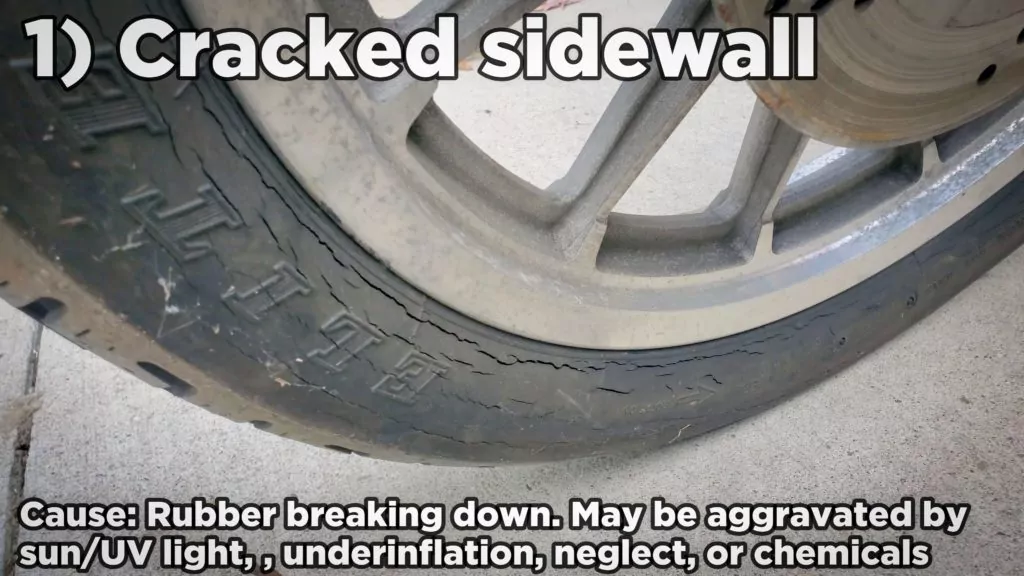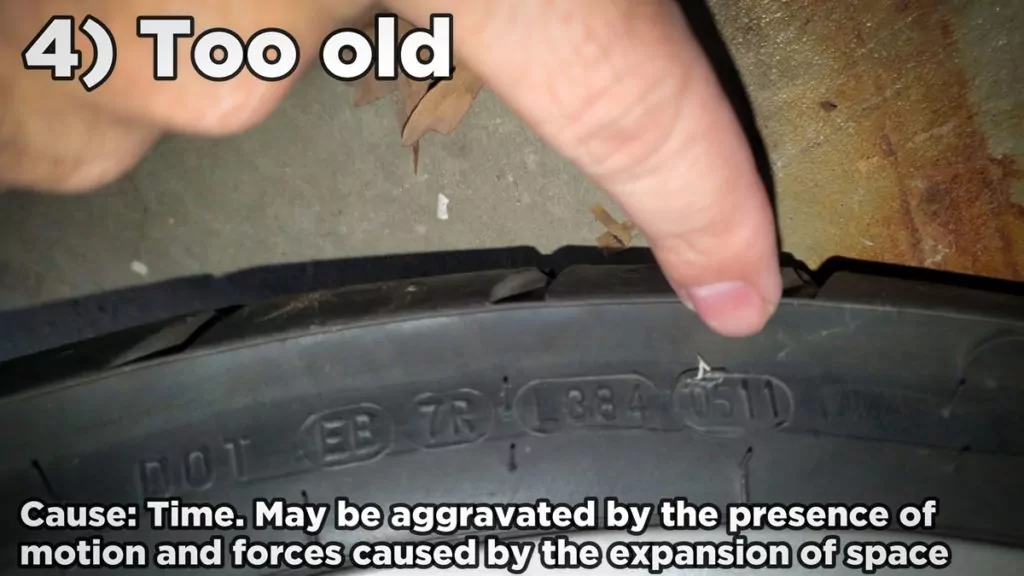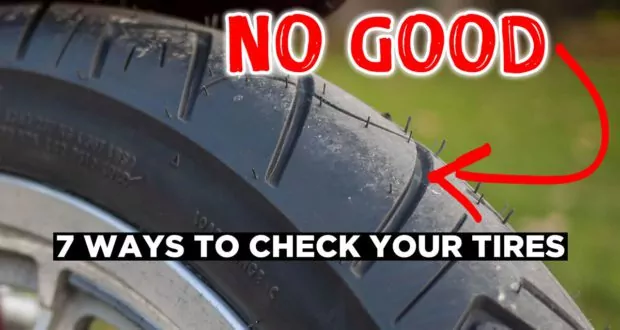Proper traction is a critical part of motorcycle riding, so knowing when to replace motorcycle tires is key for to staying safe and having fun on two wheels. Luckily, it’s easy to tell when you need a new motorcycle tire. You don’t even need to ask a mechanic for help, even if you’re a new rider.
The seven ways of knowing when to replace motorcycle tires are:
- The sidewall is cracked from dry rot
- The tire is worn out across the middle of the tire tread from a lot of use
- The tire is worn out unevenly from under inflation
- The tires are over seven to ten years old
- The tires have a bulge in the sidewall from impact or defect
- The tire has a puncture in the sidewall or near the sidewall
- The tire has a puncture greater than 7mm (about 1/4″ to 5/16″) in diameter
We’ll go over everything in detail so you’ll be sure how to know when motorcycle tires need replacing and understand whether or not any of these seven potential problems apply to you. Knowing when to replace motorcycle tires can help save you from potential accidents if you do need new rubber, and it can also help to save you from getting ripped off, so let’s get started! Here’s how to know when motorcycle tires need replacing.


1. Is your motorcycle tire sidewall cracking?
If your motorcycle tire sidewall is cracking it’s time to replace your tire, no matter shape the tire tread is in, or how much mileage the tire does or doesn’t have on it. Your motorcycle tires sidewall crack when the rubber compounds in your tire start breaking down. The tire is literally falling apart underneath you. This can be very dangerous in cornering situations where your weight is shifting from one side of the tire to the other, and the tire no longer has stability.
Your motorcycle tire sidewalls crack due to a number of reasons, including too much sun and ultraviolet light, underinflation, neglect, or chemicals. Cracked sidewalls are dangerous enough in a car, but on a motorcycle it can be deadly. If your motorcycle tire sidewalls are cracking it’s definitely time to replace your tires.

2. Do you have worn motorcycle tires?
Of course, the most common reason for a motorcycle tire to need replacing is simply that tire is worn out. Normal wear from riding in a straight line will wear out the center contact patch of a motorcycle tire. The tire is still curved around the edges but is “squared off” in the center. This can lead to dangerous handling characteristics and reduced traction.
Worn out tires make up 80% of tires being replaced at most dealerships. Riders who commute or do long highway touring on their motorcycles are more likely to experience “squared off” wear on their motorcycle tires more quickly. While the sides of the motorcycle might still be round, if the middle is getting flat, it’s time to replace your motorcycle tires.
3. Do you have uneven motorcycle tire wear?
All tires wear out with use, but not all tires wear out the same way. You can tell a lot about how a tire was used, abused, or neglected, based on the way it wears out. Sometimes even a tire with only a few thousand miles can develop uneven tire wear. This can be for a number of reasons but they all share a lack of maintenance in common.
Uneven motorcycle tire wear typically comes from underinflation. Not only will the center be kind of flat, but just off center can be jagged and may look more polygonal than round. Improper balancing if your tire balance weights came off are another potential cause of uneven tire wear. Lastly, wheel alignment being off could be another cause of uneven tire wear, so it might be time to readjust that rear tire alignment. Whatever the cause the uneven motorcycle tire wear will make your motorcycle handle irregularly which can be dangerous. You should replace the tire and keep a close eye on your replacement tire’s tire pressure and shape.
4. How long do motorcycle tires last?
How long a motorcycle tire will last varies by a number of factors including the compounds used in the rubber, what temperature the tire was stored, whether the tire was exposed to the sun, and how many heating and cooling cycles the tire experienced. According to Dunlop Tires, “You should replace the motorcycle tires if they are over five years old.” Avon Tyres seems to agree, recommending that “tires should be used within 5 years of the manufacturing date on the tire. Tires should then be removed after a total of 7 years from the manufacturing date.”
Sometimes it’s not about how many miles do motorcycle tires last, but about how old they are. Time waits for no one, not even the Michelin Man. You can see how old your tires are by looking up a code on the sidewall near the rim. You should see a series of digits that start with “DOT”. The last four digits in a circle represent the date of manufacturing of your motorcycle tires.
The format for the motorcycle tire’s date of manufacturing is WWYY, or Week Week Year Year. In other words 1015 would be the 10th week of the 2015th year. So the tire was probably made around the middle of March, 2015, meaning it’s probably due for replacement.

5. Is there a bulge in your tire sidewall?
Tires are made up of multiple layers and compounds. Sometimes, an impact can cause one of these inner layers to become damaged and form a bulge, or bubble, in the sidewall. Impacts with potholes, debris, or curbs can cause this problem. The plies inside the tire are weakened, compromising the strength of the sidewall. These can also come from manufacturing defects, however those are not common on premium and higher end tires. I worked for Goodyear and Dunlop in marketing for years and we almost never saw that.
If you’re wondering when to replace motorcycle tires, now is a good time. Like having a cracked sidewall, bulges or bubbles in your sidewall can be sketchy in cornering situations where your weight is shifting from one side to the other, and the tire does not have even strength on both sides.
6. Is there a nail in your motorcycle tire?
A nail, or any sort of puncture, in your motorcycle tire may or may not need to be replaced depending on where the nail is located. If the nail is located in the middle 75% of the tire tread, you should be okay patching the tire and continuing to get your money’s worth from your rubber.
If your nail or puncture is in the outer part of your motorcycle tire, or in your sidewall itself, than the tire will definitely need to be replaced. The far sides of the motorcycle tire’s treads flex a lot as weight shifts around, as do the sidewalls of your motorcycle tire, so we simply should not risk patching any punctures in these areas. The dangers are just too high because of all of the flexing and shifting that takes place. The patch will likely fail and the consequences could be deadly. You’re better off replacing your tire.
7. Can you patch a motorcycle tire with a nail?
Unfortunately, even if a nail is dead center in your motorcycle tire, it can’t always be patched. Tire manufacturers recommending not patching any hole greater than 7 mm (about 1/4″ to 5/16″) in diameter no matter where the puncture is located. If the nail is within the center 75% of the tire and less than 7mm, it can be patched. Anything outside of that area or smaller than that should not be patched.
Some manufacturers and dealers will even recommend not plugging or patching anything greater than 3mm (about 3/32nd”). If your puncture is up around the 7mm or 1/4″ diameter it’s definitely time for a new tire.
Final thoughts
And that’s how to know when motorcycle tires need replacing. It’s simple enough that any motorcyclist should be able to check for themselves. It’s also one of the most critical parts of restoring an old motorcycle.
Now that you know when to replace motorcycle tires, you should probably learn how to make the most of your motorcycle tires, why forged wheels are better than cast wheels, and if you want to be in awe, check out this racer who changes her tires in under 5 minutes.
 YouMotorcycle Motorcycle Blog – Motorcycle Lifestyle Blog, MotoVlog, Motorcycle Reviews, News, & How-Tos
YouMotorcycle Motorcycle Blog – Motorcycle Lifestyle Blog, MotoVlog, Motorcycle Reviews, News, & How-Tos

Great Video on the tires!!
Thanks,
G
I’d throw in another reason to switch up your motorcycle tire: when it just doesn’t vibe with your riding style. Gotta have the right tool for every job, am I right?
THANKS! Just got my first motorcycle and your content’s been a big help. Your clear and concise style helps me figure out what’s happening. Spot-on about the flaming – none of that here. Thanks again!
Adrian, your video was super helpful, especially the lowdown on the tire date on the sidewall—probably something not everyone knew. I’ve patched up a few tires – some held, some not so much haha